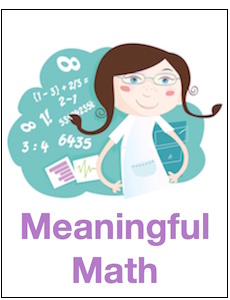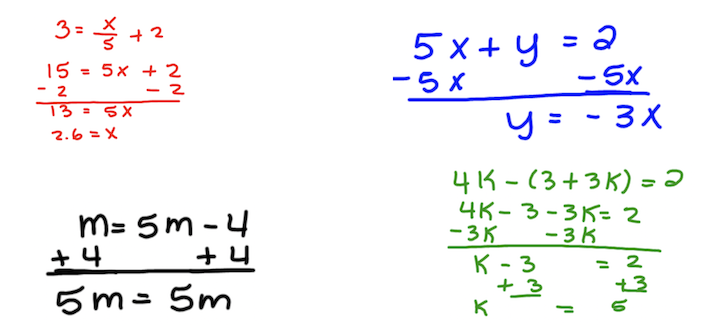Refreshing Students’ Equation Solving Skills
A MiddleWeb Blog
 This year was supposed to be a “normal” year. But we are still wearing masks, still dealing with students out for weeks at a time with COVID or quarantining from exposure to COVID.
This year was supposed to be a “normal” year. But we are still wearing masks, still dealing with students out for weeks at a time with COVID or quarantining from exposure to COVID.
In addition, it’s just a fact – my students are needing extra help.
I hesitate to say that they have “gaps in their learning” because that phrase has been so overused and I don’t necessarily think it’s true. I’m finding that students do have knowledge; they just need refreshing and reassurance and time.
On the upside, my students have been eager to learn this year, and as a result they really do try to work the problems I give them. But I started noticing that they were really struggling with solving simple equations.
I thought was odd because equation-solving has generally been an area of strength. I mentioned it to the other math teachers on my team and they were having that same issue, and the teachers in the grades below us said they noticed it, too.
I’m finding that students don’t know (or recall) the mechanics of solving equations. We spent the first two weeks of school working on solving equations. I thought that would take care of the issue but it did not. Students are still struggling, and equation-solving is so fundamental to everything else we do in math that it’s something that students have to master to be successful.
To give you an idea of what kind of misconceptions my students are having, I’ve listed some examples below.
After seeing firsthand how much my students were struggling, I started researching suggestions to help them solve equations. I also began asking my fellow teachers for help. If you are having similar experience or have a suggestion, please let me know in the comments.
Equations: Four Things I’m Doing
After some research and talking to other teachers these are some things I have tried in my classroom. As math teacher Tyne Brack says at Maneuvering the Middle, “Solving equations is foundational for middle and high school math.” This isn’t something I can skip!
1.) Automaticity and Number Sense
I am encouraging my students to learn their multiplication facts. I am trying to do so in a way that doesn’t add stress. I try to keep in mind that some of my students have anxiety around math, and some of them have had negative experiences with timed multiplication tests. But… students need to know their facts.
So I gave my students a multiplication grid to fill in every day for a week as a bell ringer. After that I started timing them. I would set the timer for five minutes. After that they graded their own work. The reward was stickers, not a grade in the gradebook. (And yes, high school students still like stickers!)
2.) Paper, Paper, Paper
Students did so much work virtually the last two years I think that contributed to their having difficulty solving equations. Although we have wonderful new resources with lots of online features, I have prioritized them solving equations on paper. I believe something (stickiness?) is lost when students work exclusively online, especially in math.
In a similar vein, I spent time at the beginning of the year emphasizing the importance of completing work in a neat and organized manner. Students were very much out of practice with this.
We started by dividing their page into eight sections using a ruler and students kept the work on each problem within one section. That sounds like a minor thing, but many students would have their work all over the paper and I couldn’t tell where one problem ended and another began. I think this ‘free-ranging’ added to their confusion as well.
3.) Immediate Feedback
Obviously I can’t give everyone immediate feedback, but I am trying to provide as much one-on-one help as I can and as quickly as I can. Students need to be able to try to solve the equation and then get feedback on what they did right and what needs correcting. I am spending lots of time walking around and looking at student work.
4.) Various Other Strategies
I have also tried the following strategies with my students. I’ve found each of these can help some students but they aren’t needed or helpful across the board.
Drawing a vertical line through the equal sign to keep things separated and to help reinforce how to perform inverse operations.
- Using highlighters to combine like terms.
- Undoing the order of operations.
What’s Next
I am starting to see improvement. My students’ work is more logical, neat and organized, and they are making fewer conceptual mistakes. But we still have more work to do.
I have been reading about learning stations, and I think that’s a strategy that might help but I haven’t tried it yet. Have you? Are middle school teachers seeing that this problem with solving equations has worsened during the pandemic?
I plan to keep revisiting solving equations until we become proficient. I know that it will take time and practice and patience. But my students are eager to learn and get better, so I’m confident that we’ll get there!
Resources
How to Teach Solving Equations by Tyne Brack at Noelle Pickering’s Maneuvering the Middle
How to Conceptually Teach Solving Equations at Tanya Yero Teaching
Helping Students Learn Linear Equations at Rethink Math Teacher





































I agree that students need to know their facts. I am not a fan of timed test as it does create math anxiety for some students. Flexibility is important. For example if a student does not know 7X9 then can think 7X10 -7. I have collected resources for fact fluency at https://bit.ly/lennyvfactfluency. There is a whole section on why Fluency is not speed. There are also some alternatives strategy to learn facts including games and flash cards.
On the algebra front I like the other suggestions. Making algebra and #facts visual is important as students develop understanding. I have had good luck with students using “picture equations” from Mashup and SPLAT from Steve Wyborney. Visually students can solve complicated equations. Links to these routines can be found at http://bit.ly/lennyvroutines